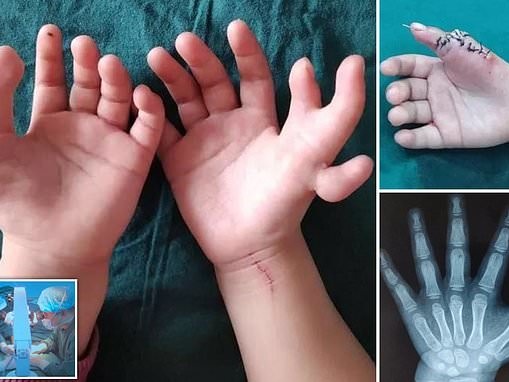A little girl born with 14 fingers has had life-changing surgery to correct her hereditary birth defect.
The three-year-old, whose name hasn’t been revealed, had two extra fingers on each hand – as well as two extra thumbs. Despite the defect going back five generations in her family, no one had ever bothered seeking help for their condition because of their poor financial situation.
The tot was treated at the Central Hospital of Shenyang Medical College in China.
Her parents had previously consulted numerous hospitals and doctors before finally settling on hand surgery specialist, Zhan Jie.
He promised that the procedure wouldn’t impact on the child’s development and would help to preserve the function and look of her hands.
The medic revealed: “The girl had two extra fingers on each hand – quite a rare patient.
“The surgery was complicated by the fact that the fingers we wanted to keep and those we wanted to remove weren’t clear and obvious.
“Besides removing the extra digits, we also needed to make corrections to the angle.”
Dr Zhan and his team were able to remove the extra digits as well as straighten the girl’s thumbs and redirect the bone growth with the help of metal rods.
They hoped that she’d now be able to grow up free from any potential stigma associated with the condition.
“It’s been a month since the operation. She came back after two weeks to have her sutures removed,” Doctor Zhan said.
He added: “Both we and the patient’s family are satisfied with the appearance of her hands.”
Medics didn’t confirm what the girl’s defect actually was but polydactyly is a condition which causes babies to be born with too many fingers and toes.
What is Polydactyly?
Polydactyly is a birth defect that occurs when a person is born with extra fingers or toes. It affects around one in every 700-to-1,000 births worldwide.
During the sixth or seventh week of pregnancy, a foetus’ ‘paddle hands and feet’ divide into fingers and toes. Polydactyly occurs when the ‘paddle’ splits too many times.
Polydactyly is thought to occur randomly but may have a genetic element or be linked to an underlying condition. The condition is usually spotted on an ultrasound scan.
Surgery to remove the extra digits usually occurs when a child is one or two years old. This should leave them with a hand or foot that functions, and looks, as normal.
Culled from dailymail.co.uk & the sun.co.uk

 Join Daily Trust WhatsApp Community For Quick Access To News and Happenings Around You.
Join Daily Trust WhatsApp Community For Quick Access To News and Happenings Around You.


